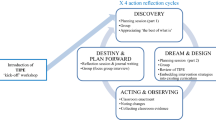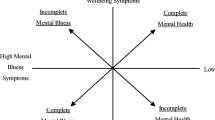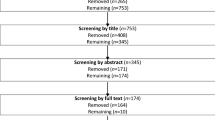Abstract
Social workers provide much of the mental health treatment in the United States, and, given the ubiquity of trauma, most clinical social workers will provide treatment to trauma survivors during their careers. Therefore, trauma theory and practice must be included in MSW curricula and taught as a clinical course. This paper suggests that experienced clinician instructors teach trauma theory and practice classes using a case-based method. Bringing case material into the classroom helps prepare students for the complexities and challenges of treating survivors of trauma. To demonstrate how cases can help students connect theory to practice, the paper presents the treatment of a Central African asylum seeker recovering from trauma. The case emphasizes the centrality of the therapeutic relationship and illustrates the use of several evidence-supported trauma interventions along with core principles of social work practice. Finally, the paper suggests that social work educators consider developing a structured method of integrating cases into the trauma curriculum.
Similar content being viewed by others
References
American Psychiatric Association. (2013). Diagnostic and statistical manual of mental disorders (5th ed.). Arlington, VA: American Psychiatric Publishing.
Applegate, J. S. (1993). Winnicott and clinical social work: A facilitating partnership. Child and Adolescent Social Work Journal, 10, 3–19.
Applegate, J. S., & Shapiro, J. R. (2005). Neurobiology for clinical social work: Theory and practice. New York: Norton.
Benish, S., Imel, Z. E., & Wampold, B. E. (2007). The relative efficacy of bona fide psychotherapies for treating post-traumatic stress disorder: A meta-analysis of direct comparisons. Clinical Psychology Review, 28, 746–758.
Bogo, M. (2005). Field instruction in social work: A review of the research literature. The Clinical Supervisor, 24, 163–193.
Bromberg, P. M. (2003). Something wicked this way comes. Trauma, dissociation, and conflict: The space where psychoanalysis, cognitive science, and neuroscience overlap. Psychoanalytic Psychology, 20, 558–574.
Cloitre, M., Courtois, C. A., Charuvastra, A., Carapezza, R., Stolbach, B., & Green, B. L. (2011). Treatment of complex PTSD: Results of the ISTSS expert clinician survey on best practices. Journal of Traumatic Stress, 24, 615–627.
Cossom, J. (1991). Teaching from cases: Education for critical thinking. Journal of Teaching in Social Work, 5, 139–155.
Courtois, C. A., & Ford, J. D. (Eds.). (2009). Treating complex traumatic stress disorders: An evidence-based guide. New York: Guilford.
Courtois, C. A., Ford, J. D., & Cloitre, M. (2009). Best practices in psychotherapy for adults. In C. A. Courtois & J. D. Ford (Eds.), Treating complex traumatic stress disorders: An evidence-based guide (pp. 82–103). New York: Guilford.
Cozolino, L. (2002). The neuroscience of psychotherapy: Building and rebuilding the human brain. New York: Norton.
Cukor, J., Olden, M., Lee, F., & Difede, J. (2010). Evidence-based treatments for PTSD, new directions, and special challenges. Annals of the New York Academy of Sciences, 1208, 82–89.
Davies, J. M., & Frawley, M. G. (1994). Treating the adult survivors of childhood sexual abuse. New York: Basic Books.
Dyche, L., & Zayas, L. H. (2001). Cross-cultural empathy and training the contemporary psychotherapist. Clinical Social Work Journal, 29, 245–258.
Erikson, E. H. (1980). Identity and the life cycle (2nd ed.). New York: Norton.
Friedman, M. J., Resick, P. A., & Keane, T. M. (2007). PTSD: Twenty-five years of progress and challenges. In M. J. Friedman, T. M. Keane, & P. A. Resick (Eds.), Handbook of PTSD: Science and practice (pp. 3–18). New York: Guilford.
Garvin, D. A. (1991). Barriers and gateways to learning. In C. R. Christensen, D. A. Garvin, & A. Sweet (Eds.), Education for judgment: The artistry of discussion leadership (pp. 3–13). Boston: Harvard Business School.
Gelman, C. R., & Mirabito, D. M. (2005). Practicing what we teach: Using case studies from 9/11 to teach crisis intervention from a generalist perspective. Journal of Social Work Education, 41, 479–494.
Goldstein, E. G. (2007). Social work education and clinical learning: Yesterday, today, and tomorrow. Clinical Social Work Journal, 35, 15–23.
Habermas, T., & Paha, C. (2002). Souvenirs and other personal objects: Reminding of past events and significant others in transition to university. In J. D. Webster & B. K. Haight (Eds.), Critical advances in reminiscence work (pp. 123–139). New York: Springer.
Herman, J. L. (1992). Trauma and recovery. New York: Basic Books.
Hobfoll, S. E., Watson, P., Bell, C. C., Bryant, R. A., Brymer, M. J., Friedman, M. J., et al. (2007). Five essential elements of immediate and mid-term mass trauma intervention: Empirical evidence. Psychiatry, 70, 283–315.
Hollis, F., & Woods, M. E. (1981). Casework: A psychosocial therapy (3rd ed.). New York: Random House.
Horowitz, J. (1998). Contemporary psychoanalysis and social work theory. Clinical Social Work Journal, 26, 369–383.
Janoff-Bulman, R. (1992). Shattered assumptions: Toward a new psychology of trauma. New York: Free Press.
Jones, K. A. (2003). Making the case for the case method in graduate social work education. Journal of Teaching in Social Work, 23, 183–200.
Laub, D. (1992). Bearing witness or the vicissitudes of listening. In S. Feldman & D. Laub (Eds.), Testimony: Crises of witnessing in literature, psychoanalysis and history (pp. 57–74). New York: Routledge.
Masiriri, T. (2008). The effects of managed care on social work mental health practice. SPNA Review, 4(1), Article 6. Retrieved from http://scholarworks.gvsu.edu/spnareview/vol4/iss1/6.
Middleman, R. R., & Wood, G. G. (1991). Helping students learn from each other. Journal of Teaching Social Work, 5(2), 31–40.
Naturale, A. (2007). Secondary traumatic stress in social workers responding to disasters: Reports from the field. Clinical Social Work Journal, 35, 173–181.
Richmond, M. (1922). What is social case work? New York: Russell Sage Foundation.
Shapiro, J. R., & Applegate, J. S. (2000). Cognitive neuroscience, neurobiology and affect regulation: Implications for clinical social work. Clinical Social Work Journal, 28, 9–21.
Shonfeld-Ringel, S. (2001). A reconceptualization of the working alliance in cross-cultural practice with non-western clients: Integrating relational perspectives and multicultural theories. Clinical Social Work Journal, 29, 53–63.
Shulman, L. S. (1992). Toward a pedagogy of cases. In J. H. Shulman (Ed.), Case methods in teacher education (pp. 1–30). New York: Teachers College Press.
Shulman, L. S. (2005). Signature pedagogies in the professions. Daedalus, 134(3), 52–59.
Siegel, D. J. (2003). An interpersonal neurobiology of psychotherapy: The developing mind and the resolution of trauma. In M. F. Solomon & D. J. Siegel (Eds.), Healing trauma (pp. 1–56). New York: Norton.
Simpson, G. A., Williams, J. C., & Segall, A. B. (2007). Social work education and clinical learning. Clinical Social Work Journal, 35, 3–14.
Spinazzola, J., Blaustein, M., & van der Kolk, B. (2005). Posttraumatic stress disorder treatment outcome research: The study of unrepresentative samples? International Society for Traumatic Stress Studies, 18, 425–436.
Stolorow, R. D. (1994). The intersubjective context of intrapsychic experience. In R. D. Stolorow, G. E. Atwood, & B. Bandchaft (Eds.), The intersubjective perspective (pp. 3–14). Northvale, NJ: Jason Aronson.
Stolorow, R. D. (2007). Trauma and human existence. New York: The Analytic Press.
Tedeschi, R. G., & Calhoun, L. G. (2004). Posttraumatic growth: Conceptual foundations and empirical evidence. Psychological Inquiry, 15, 1–18.
Tosone, C. (2004). Relational social work: Honoring the tradition. Smith College Studies in Social Work, 74, 475–478.
Tosone, C., & Bialkin, L. (2004). Mass violence and secondary trauma: Issues for the clinician. In S. L. A. Straussner & N. K. Phillips (Eds.), Understanding mass violence: A social work perspective (pp. 157–167). New York: Pearson.
Tosone, C., Nuttman-Shwartz, O., & Stephens, T. (2012). Shared trauma: When the professional is personal. Clinical Social Work Journal, 40, 231–239.
van der Kolk, B. A. (2009). Afterword. In C. A. Courtois & J. D. Ford (Eds.), Treating complex traumatic stress disorders: An evidence-based guide (pp. 455–466). New York: Guilford.
Wayne, J., Bogo, M., & Raskin, M. (2010). Field education as the signature pedagogy of social work education. Journal of Social Work Education, 46, 327–339.
Acknowledgments
The authors wish to thank Jeffrey Applegate, PhD, for generously reading this manuscript several times as it evolved. We appreciate his thoughtful, incisive theoretical and editorial comments and his encouragement.
Author information
Authors and Affiliations
Corresponding author
Rights and permissions
About this article
Cite this article
Abrams, J., Shapiro, M. Teaching Trauma Theory and Practice in MSW Programs: A Clinically Focused, Case-Based Method. Clin Soc Work J 42, 408–418 (2014). https://doi.org/10.1007/s10615-013-0472-z
Published:
Issue Date:
DOI: https://doi.org/10.1007/s10615-013-0472-z




